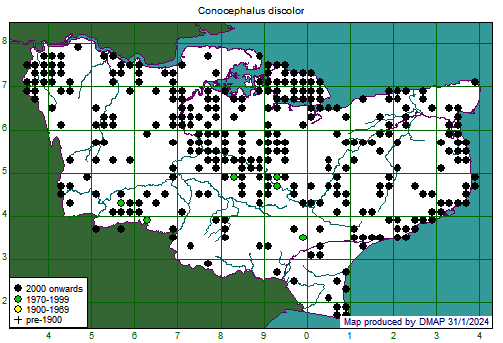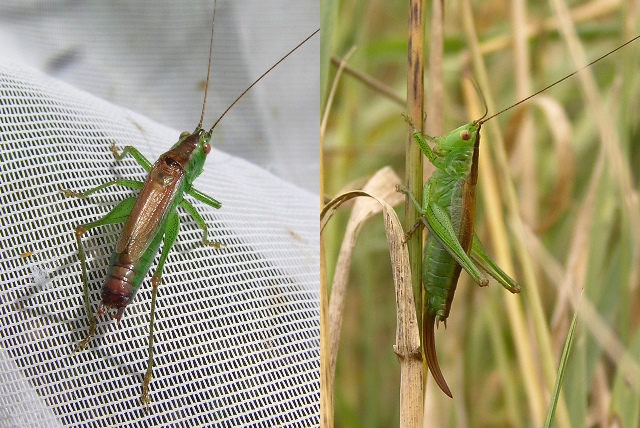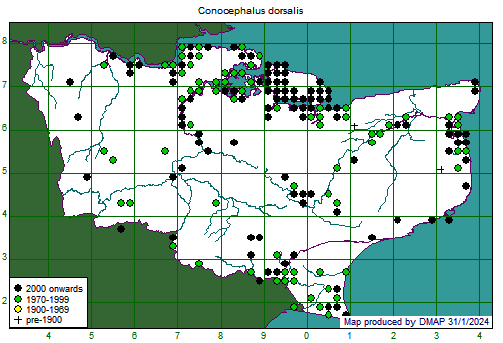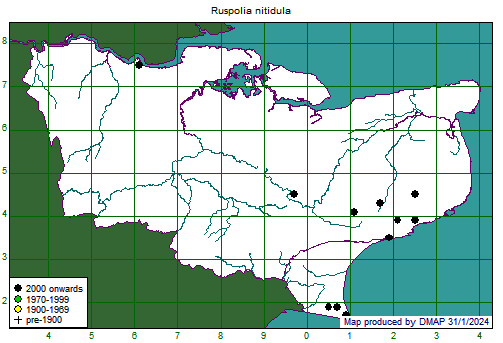Long-winged Conehead Conocephalus fuscus (C. discolor)
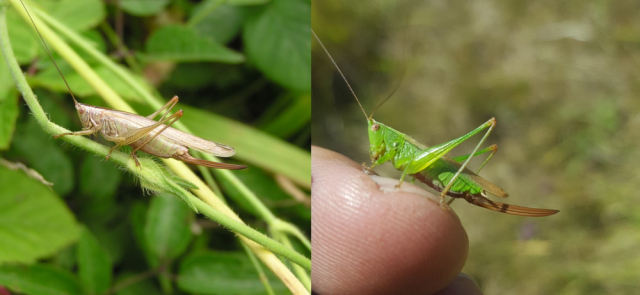
Left: Long-winged Conehead, an extra-long-winged female of the brown colour-form. Right: A female with the more common length of wings and more common green colour-form. Photos R I Moyse.
A distinctive, slender bush-cricket which was first recorded in Britain in the 1930s but only started to spread towards the end of that century. It was first recorded in Kent in 1990, and is now ubiquitous in tall, grassy vegetation, whether on dry downland or in wet marshland. The male's song is a continuous, steady, high-pitched buzz which is easy to recognise (though similar to the song of the Short-winged Conehead).
Map showing records at tetrad (2km x 2km square) resolution. Colour of dot shows date-class of most recent record for that tetrad.
Short-winged Conehead Conocephalus dorsalis
Short-winged Coneheads: male (left) and female (right). Photos R I Moyse.
A wetland species found in tall, grassy or rushy vegetation on coastal and riverine marshes. There is a long-winged form of this species, so wing-length alone is not enough to separate the two cone-heads. The form of the ovipositor, which is straight in Long-winged Conehead and curved in Short-winged, is the easiest distinguishing feature. The male's song also differs: in the Short-winged Conehead, the buzzing includes periods when it slows to a steady ticking before speeding up again; in Long-wing Conehead, the buzzing only slows when the song is coming to a stop.
The map below includes a large number of tetrads with no records after 1999, which suggests that this may be a declining species in Kent. Anecdotal evidence suggests that Short-winged Conehead used to be more abundant in coastal and riverine marshland, using dry grassland on sea-walls as well as wetter habitats. Now, however, it seems to be largely confined to the wettest places, often being found only amongst rushes which are standing in water. The drier marshland seems now to be occupied by Long-winged Coneheads, though whether there is direct competition or Short-winged Conehead is responding to drier summer weather is unclear. It seems unlikely that Short-winged Conehead has vanished from all those places it was recorded in the latter part of the 20th Century (green dots on the map below), but it may be a lot less abundant where it does occur and so less likely to be recorded.
Map showing records at tetrad (2km x 2km square) resolution. Colour of dot shows date-class of most recent record for that tetrad.
Large Conehead Ruspolia nitidula
A species almost as large as the Great Green Bush-cricket, though more slender and with a distinctive, pointed head. The song is loud and distinctive, but mainly produced at night. Large Conehead was previously known from a handful of records in Scilly and Dorset, but in 2020 individuals were found at Bexhill in East Sussex, and at Hothfield Common in Kent, followed by the discovery of a colony of around 30 individuals at Dungeness. Since then, the colony at Dungeness has persisted, though it is not clear whether the species is still present at Hothfield as a visit in 2023 failed to find any sign. The species has also expanded its distribution in the areas inland of Folkestone and Dover, and one was also found at Swanscombe in North-west Kent in 2023.
Map showing records at tetrad (2km x 2km square) resolution. Colour of dot shows date-class of most recent record for that tetrad.

